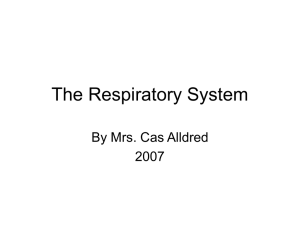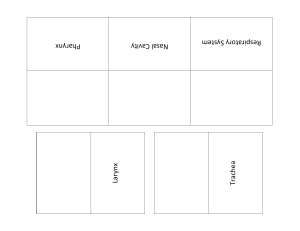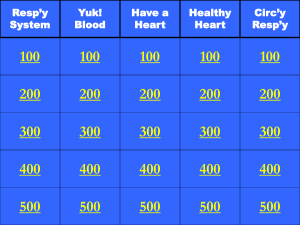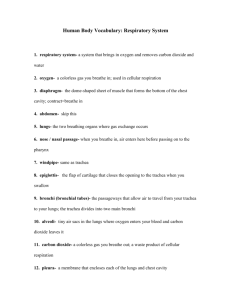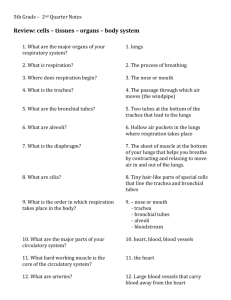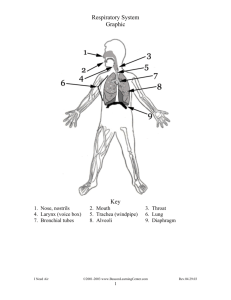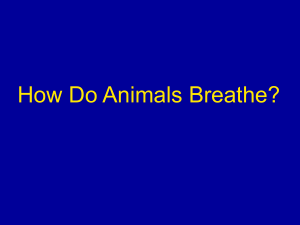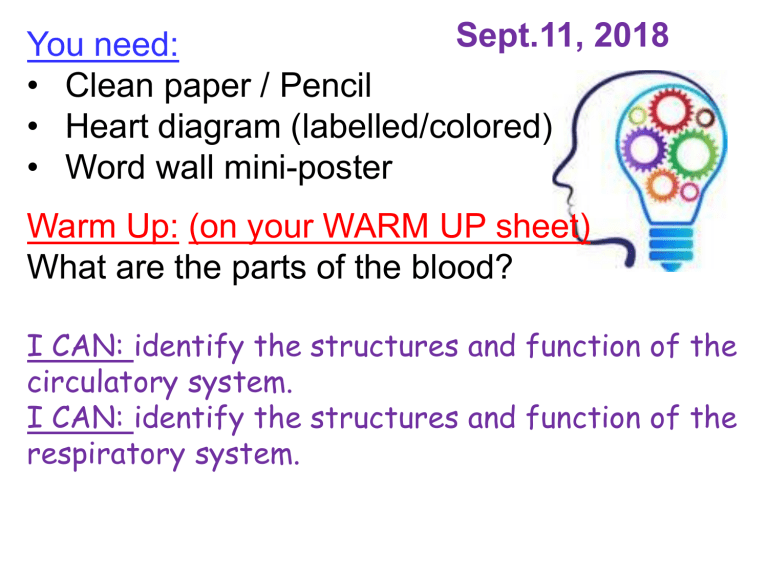
Sept.11, 2018 You need: • Clean paper / Pencil • Heart diagram (labelled/colored) • Word wall mini-poster Warm Up: (on your WARM UP sheet) What are the parts of the blood? I CAN: identify the structures and function of the circulatory system. I CAN: identify the structures and function of the respiratory system. Be the positive. It takes many “put-ups” to cancel a “put-down.” MRS NERG-C M - Movement R – Respirations S – Sensitivity (responds to stimulus) N – Nutrition / nutrients E - Excretion R – Reproduces G - Growth C - Cells Body Organization Organism Organ System Organ Tissue Cell The Digestive System The digestive system has 3 main functions: 1. It breaks down food into particles that the body can use. 2. It absorbs nutrients into the blood. 3. It eliminates waste from the body. Mouth Esophagus The Excretory system Eliminates waste from the body. What does it do for us? Our circulatory system… • Delivers necessary materials (like oxygen and sugar) to the entire body in the blood, • Removes waste products from cells, and • Helps fight disease by transporting immune cells in the blood. • From Body So, the detailed path of blood in your body would look like this: • Right Atrium • Right Ventricle • To Lungs • From Lung • Left Atrium • Left Ventricle • To Body Lung Body Heart labels To LUNGS From LUNGS To LUNGS Right atrium Right Ventricle From LUNGS What carries the blood? • BLOOD VESSELS are the hollow tubes that carry your blood around your body. • There are 3 TYPES: – ARTERIES – CAPILLARIES – VEINS What is your blood? Red Blood Cells carry oxygen. White blood cells fight disease. Platelets form blood clots to stop you from bleeding too much. Tracking a Hurricane How can we use maps, satellite, and radar to predict where this hurricane will hit? Hurricane Florence 1 (West, North) (57, 24.4) 9/09/18 Wind (mph) 85 2 (57.7, 24.6) 9/10/18 90 3 (58.9, 24.9) 9/10/18 105 4 (60, 25) 9/10/18 115 5 (61.1, 25.4) 9/10/18 140 6 (62.4, 25.9) 9/11/18 140 7 (64.1, 26.4) 9/11/18 140 8 Day Category Category 1 Category 1 Category 2 Category 3 Category 4 Category 4 Category 4 Florence 35 N 34.2 N, 77.9 W 30 N 25 N 80 W 75 W 70 W So what happens if you don’t take care of your circulatory system? Not enough good stuff to your body Build up of bad stuff in your body Heart Attack! - Breathe in and out… What is the RESPIRATORY SYSTEM? • The system of the body that deals with BREATHING. • It consists of the NOSE, PHARYNX, TRACHEA, BRONCHIAL TUBES, and LUNGS. - Breathe in and out… What is the FUNCTION of the System? Respiratory • To DELIVER OXYGEN to the body. • To REMOVE CARBON DIOXIDE from the body. - Breathe in and out… Why does the body need oxygen? • The body’s CELLS use OXYGEN to release ENERGY to the body. • CELLULAR RESPIRATION is the CHEMICAL REACTION that uses GLUCOSE & OXYGEN to release ENERGY. • CARBON DIOXIDE is a WASTE PRODUCT of this chemical reaction. - Breathe in and out… Which systems work together? • RESPIRATORY SYSTEM gets OXYGEN from the air. • DIGESTIVE SYSTEM gets GLUCOSE from food. • CIRCULATORY SYSTEM DELIVERS oxygen and glucose to cells. In the cells, respiration uses glucose and oxygen to release ENERGY. What path does AIR flow? • Try it • Use the words on your table and work with your elbow partner to put them in order. • Raise your hand when you are done. - Breathe in and out… What path does AIR follow? • • • • NOSE PHARYNX TRACHEA BRONCHIAL TUBES • LUNGS (alveoli) - Breathe in and out… What happens in each part? NOSE – in the nasal cavity, the air is: – Warmed, – FILTERED, and – moistened. (Mucus and nasal hairs keep out dust, pollen and other particles). • PHARYNX – air passes through the THROAT when breathing. The EPIGLOTTIS covers the trachea when you SWALLOW to prevent FOOD from entering the trachea when you eat/drink. - Breathe in and out… What happens in each part? • TRACHEA – is the WINDPIPE that leads to the lungs. It is a TUBE with RINGS OF CARTILAGE. • BRONCHIAL TUBES – are the the short tubes that branch off the trachea TO CARRY AIR TO the LUNGS. - Breathe in and out… What happens in each part? • LUNGS – inside the lungs, the bronchi branch into SMALLER TUBES. At the end of the smallest tubes, are structures called ALVEOLI. • ALVEOLI – are AIR SACS, surrounded by CAPILLARIES. This where BLOOD picks up OXYGEN and gets rid of CARBON DIOXIDE. - Breathe in and out… What happens in the ALVEOLI? • GAS EXCHANGE - Blood from the body enters the lungs. In the alveoli, the blood GETS RID OF CARBON DIOXIDE and PICKS UP OXYGEN before returning to the heart to take oxygen to rest of the body. How do we BREATHE? How are BREATHING & SPEAKING related? • Air that you BREATHE OUT when you exhale also helps you SPEAK. • Your LARYNX is your VOICE BOX which has 2 VOCAL CHORDS that move and produce sound when air passes through the opening between them. Larynx Mythbusters • Helium to speak Let’s make a demo! • At your table, you have a bottle, balloons, rubber bands, and straw “thing” • Stretch the balloon over the bottom of the bottle…the open area. Secure the balloon with a rubber band. • Place the straw “thing” into the bottle and screw the top on. • Pinching the balloon that you stretched on the bottle, pull down. What happens to the balloon on the straw “thing”? Why? Are there any questions?
